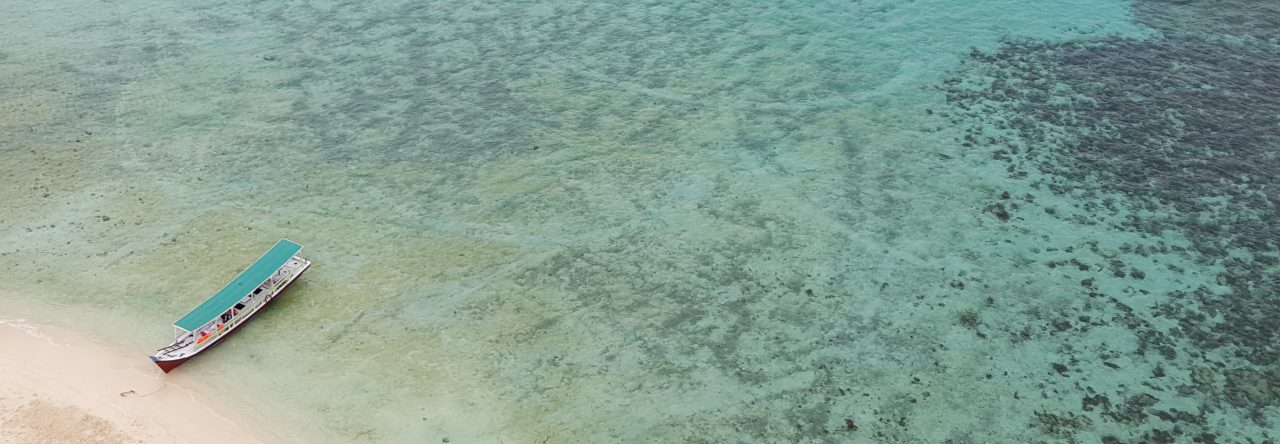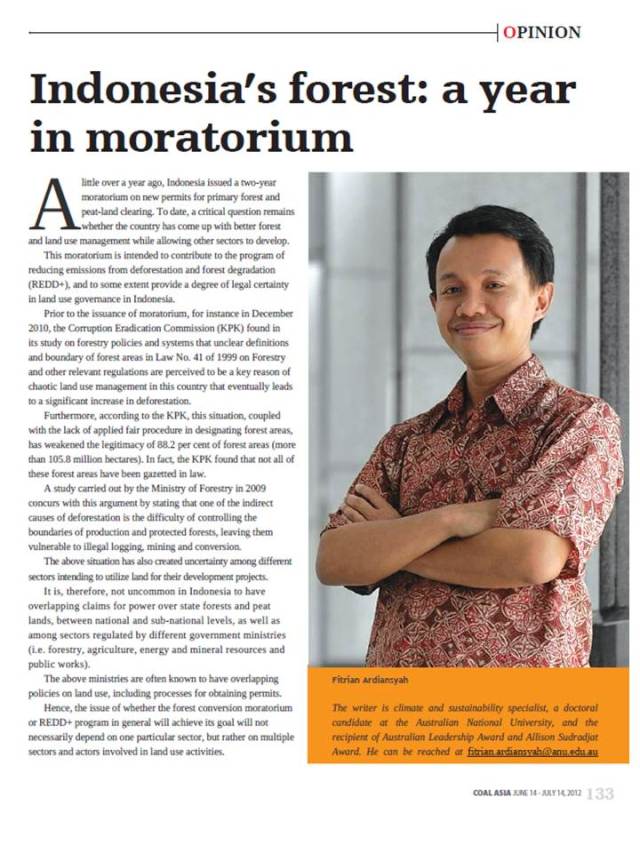Published in COAL ASIA MAGAZINE, OPINION, JUNE 14-JULY 14, 2012, PAGE 133-134 and OGE ASIA MAGAZINE, OPINION, JUNE 25-JULY 25, 2012, PAGE 50-51
To see the pdf version, please click Opini_CoalAsia_July2012 and/or opini OGE
A little over a year ago, Indonesia issued a two-year moratorium on new permits for primary forest and peat-land clearing. To date, a critical question remains whether the country has come up with better forest and land use management while allowing other sectors to develop.
This moratorium is intended to contribute to the program of reducing emissions from deforestation and forest degradation (REDD+), and to some extent provide a degree of legal certainty in land use governance in Indonesia.
Prior to the issuance of moratorium, for instance in December 2010, the Corruption Eradication Commission (KPK) found in its study on forestry policies and systems that unclear definitions and boundary of forest areas in Law No. 41 of 1999 on Forestry and other relevant regulations are perceived to be a key reason of chaotic land use management in this country that eventually leads to a significant increase in deforestation.
Furthermore, according to the KPK, this situation, coupled with the lack of applied fair procedure in designating forest areas, has weakened the legitimacy of 88.2 per cent of forest areas (more than 105.8 million hectares). In fact, the KPK found that not all of these forest areas have been gazetted in law.
A study carried out by the Ministry of Forestry in 2009 concurs with this argument by stating that one of the indirect causes of deforestation is the difficulty of controlling the boundaries of production and protected forests, leaving them vulnerable to illegal logging, mining and conversion.
The above situation has also created uncertainty among different sectors intending to utilize land for their development projects.
It is, therefore, not uncommon in Indonesia to have overlapping claims for power over state forests and peat lands, between national and sub-national levels, as well as among sectors regulated by different government ministries (i.e. forestry, agriculture, energy and mineral resources and public works).
The above ministries are often known to have overlapping policies on land use, including processes for obtaining permits.
Hence, the issue of whether the forest conversion moratorium or REDD+ program in general will achieve its goal will not necessarily depend on one particular sector, but rather on multiple sectors and actors involved in land use activities.
Given such complexity, it appears that the REDD+ taskforce, which is given a mandate by Indonesia’s President to develop the national REDD+ strategy and oversee the moratorium, has achieved some initial progress in working with different agencies and sectors, particularly to arrive at an agreed moratorium indicative map (MIM), which would contribute to avoiding confusion and creating legal certainty.
The agencies engaged include the National Survey and Mapping Coordinating Agency (Bakosurtanal), the Ministry of Forestry, the Ministry of Agriculture, the National Land Agency (BPN) and the President’s Delivery Unit for Development Monitoring and Oversight (UKP4).
The MIM, required to outline the areas covered in the moratorium, is being updated every six months incorporating the latest sets of data from the above agencies and results from site visits. A second MIM is currently available, albeit with some discrepancies of figures between the two maps, as reported by the taskforce.
Since there are many sectors, layers of government and actors involved, it is understandable that to get an agreed MIM, some additions or reductions of relevant forest and land cover figures are required. Also, negotiations and trade-offs are likely to take place among these sectors and actors.
The future of this moratorium (including the improvement of MIM) and the overall national REDD+ strategy will depend so much on whether the initiative could increase positive involvement of the businesses, actors, and layers of government that are influential in causing land use change.
The development sectors of forestry (e.g. logging concessions, industrial timber plantations), agriculture (e.g. oil palm plantations), mining, and infrastructure are the key players in Indonesia’s development, and therefore their involvement and coordination in the moratorium and REDD+ process is crucial.
Gaining positive involvement or support from these actors and sector is truly a challenge, especially if the moratorium and REDD+ strategy do not clearly lay out the subsequent steps that allow these sectors to develop options.
For instance, there is a need to further improve data quality and transparency, showing which areas are protected (“no go areas” for development) and are not (“go areas” – that could include fallow lands and degraded lands).
According to the World Resource Institute (WRI), although releasing the current map was a landmark step toward improved transparency, the additional data provided were incomplete, did not include metadata, were difficult to download, and were not up to date.
Without accurate data on forestry and other permits, it is a herculean task for the government to enforce the moratorium and for the private sector to invest in areas that will not replace forests or peat lands.
The WRI argues that technically sound, legally accurate, and up-to-date spatial data, including license and permit data, should be made available, independently reviewed, maintained, and continuously improved.
Another fundamental factor that could lead to attracting positive support from these actors and sectors is the provision of positive incentives to get out of unsustainable practices and eventually maintain and properly manage forests and peat lands.
Currently, the private sector, communities and local governments have little direct incentive to manage and conserve these natural ecosystems.
In fact, there are cases when incentives planned to be used for better forest management (e.g. the Reforestation Fund) have been abused. As a result, the figures of forest degradation and deforestation further increase dramatically.
On the contrary, there are big investments for large-scale development in different sectors, which lead to greater exploitation of forest and peat land resources.
Market access for sustainable products and REDD+ fund for better forest and land use management can be named as potential candidates of incentives provided for land use actors who would like to pursue sustainable practices.
The question, however, still remains as to whether these incentives will be able to compete with such big investments which have thus far been responsible for changing Indonesia’s land use patterns.
World Bank in 2006 argues that adequate positive incentives are required, and must go hand-in-hand with forest law enforcement and governance initiatives, to increase the costs of non-compliance.
According to the Bank, insufficient incentives, on the other hand, would not result in a long term investment in and stewardship of forests and production facilities which are important to ensure the reduction of deforestation and forest degradation.
A year of experience in implementing this two-year forest conversion moratorium provides a good reminder for Indonesia and its citizens that the challenges of achieving better land use and forest management while developing its economy are greater than ever.
The above mentioned issues, include, among others, increasing legal certainty as well developing options and incentives for sustainable practices, need to be further addressed, quickly and seriously.
Failure to address these issues may hinder the development and implementation of the moratorium, the overall REDD+ program and consequently disrupt Indonesia’s opportunity to develop its economy in a greener and sustainable way.
The writer is climate and sustainability specialist, a doctoral candidate at the Australian National University, and the recipient of Australian Leadership Award and Allison Sudradjat Award. He can be reached at fitrian.ardiansyah@anu.edu.au



Pingback: REDD in the news: 9-15 July 2012 | redd-monitor.org
mantaaps….bravo mas!
Makasih Pak Ral
Pingback: INDONESIA: Ad un anno della moratoria per la salvaguadia delle foreste - Le terre sotto vento